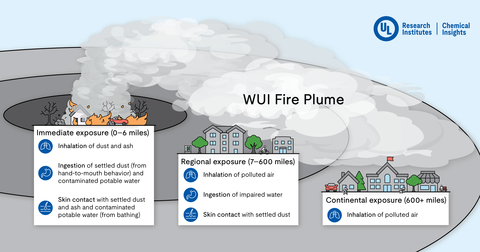ATLANTA– Chemical Insights Research Institute (CIRI) of UL Research Institutes applies cutting edge technologies to evaluate the toxicity of burn-impacted land areas affected by the August 2023 Lahaina wildfires. Created with CIRI research partners from Duke University and the East-West Center (EWC) in Hawai’i, the study known as Lahaina Environmental Assessment Project (LEAP), will collect and analyze residual dust, soil and ash samples from properties affected by the fires. These residues, including fine dust, can infiltrate schools, homes and office buildings and can also be recirculated into the air. Exposure may contribute to acute and chronic health concerns from inhalation of the dust or ingestion from frequent hand to mouth transfer. Residues may also contaminate the local ecosystem and wash into waterways.
CIRI is applying a combination of real-time and laboratory analytical chemistry techniques with high-resolution environmental sampling maps to determine the spatial relationships among the locations, types, and levels of volatile organic compounds (VOCs) and metals associated with fire residues. Samples from over 60 properties in the fire-affected areas are being collected for study. Information gained will contribute to scientific knowledge on health risks of toxic residues left in the aftermath of wildland urban interface (WUI) specific fires. Currently, there is little data on this topic, yet WUI fires are exponentially growing, adversely affecting local communities and extended regions.
“An understanding of these risks is critical to mitigating people exposure and developing community clean up and land reuse strategies,” said Dr. Marilyn Black, VP and Senior Technical Advisor for CIRI, who also co-authored the National Academy’s report titled, The Chemistry of Fires at the Wildland-Urban Interface. “CIRI’s scientific advances with the assistance of its research partners at Duke and EWC will help unravel the complexities of WUI fires, the fate of resulting contamination, and steps for protecting public health.”
“With more than 4,500 households displaced by the fires, the likely contamination of the soil, water, and air is also an important factor in the rebuilding process from a public health perspective,” according to Dr. Sumeet Saksena, Senior Fellow at the East-West Center. “We are working to identify sources on the properties that may have led to unique contamination when they burned, such as vehicles, solar panels, and home appliances.”
Analysis of the samples will be done in CIRI’s Center for Advanced Measurements in Marietta, Georgia. CIRI will use its newly developed environmental Dust VOC (DVOC)™ methodology to analyze a wide range of VOCs in one sample with detection in the parts-per-trillion level. Preliminary evaluations of Maui burn residue using CIRI’s methodology have identified over 500 different VOCs that can be assessed for health concerns. Preliminary analyses of the residue samples also found the presence of metals of concern including arsenic, lead, chromium and lithium.


